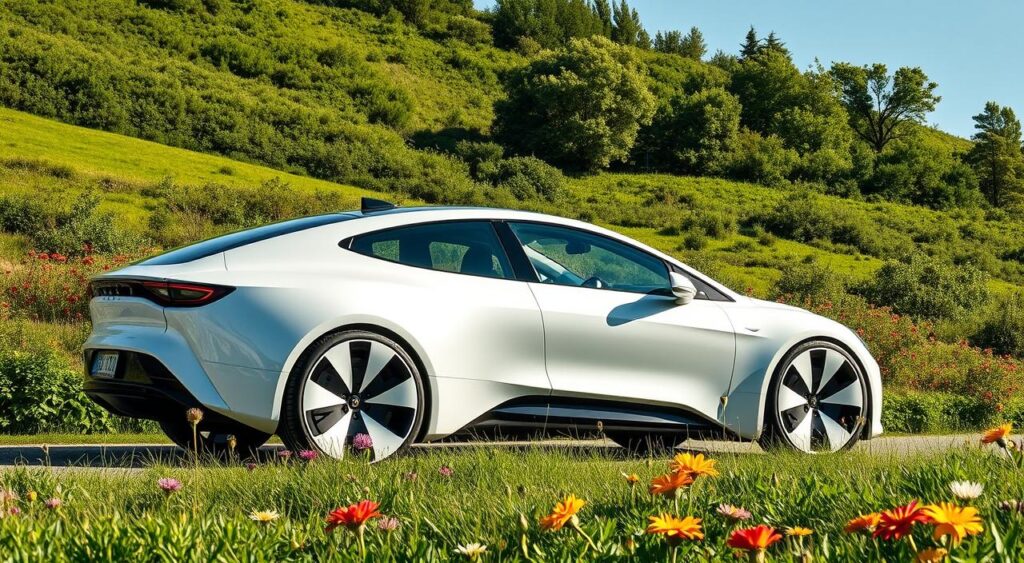The future of cars is green, with eco-friendly cars leading the way. Drivers in the U.S. are choosing hybrid and electric cars. They know these choices help the planet.
These cars use new tech to cut down on pollution and save energy. They also make the air cleaner. This means a better tomorrow for all of us.
But, how green are these cars really? It depends on where the electricity comes from. Using solar, wind, or hydroelectric power is key. This keeps emissions low from start to finish.
By using clean energy to charge them, drivers help the planet. They also enjoy the perks of driving green. This is a step towards a greener future.
Key Takeaways
- Eco-friendly cars, including hybrid and electric vehicles, are the future of sustainable transportation.
- Renewable energy integration is key for the environmental benefits of electric cars.
- Governments offer incentives and tax credits for eco-friendly vehicles.
- Electric vehicles cost less to run and need less maintenance.
- Electric car sales are rising, showing more people want green cars.
The Rise of Sustainable Transportation
The car industry is changing fast, moving towards green vehicles. Electric cars and hybrids are leading the way. They help cut down on pollution and make our future greener.
Embracing the Eco-Friendly Car Revolution
Electric and hybrid cars are getting more popular. They use less fuel and don’t pollute. By 2030, batteries for these cars will need a lot of power, showing how fast this industry is growing.
As technology improves and more places get charging stations, more people will choose green cars. This is a big step towards a cleaner world.
The Environmental Impact of Conventional Vehicles
Gasoline cars harm our environment a lot. They pollute the air, contribute to climate change, and more. Electric cars, on the other hand, are better for the planet, even when you consider how electricity is made.
Switching to electric cars is key to fighting climate change. It’s a step towards a greener future for all of us.
Electric cars are a big step towards a cleaner world. They offer new tech and save money in the long run. As more people buy them, prices will drop, making them even more appealing.

“The future of transportation is electric, and the time to embrace this revolution is now. By choosing eco-friendly cars, we can all contribute to a cleaner, more sustainable world.”
Electric Vehicles: Paving the Way Forward
Electric vehicles (EVs) are leading the way in the eco-friendly car revolution. They offer a promising solution for sustainable transportation. These cars use electric propulsion systems, changing the future of green driving.
The Advantages of Electric Propulsion Systems
Electric vehicles have a big advantage: they produce zero direct emissions. This helps keep the air clean and makes the planet healthier. They also have smoother acceleration and better energy efficiency than traditional cars. This makes your daily drive more fun and saves money.
- By January 2023, electric vehicles had claimed 10% of the global market share.
- In May of the same year, the Tesla Model Y became the world’s best-selling vehicle.
- Estimates suggest that by the middle of the century, over half of the vehicles on the road will be electric.
The demand for eco-friendly cars is growing fast. This is making the switch to electric vehicles happen quicker. Companies like Kia are leading the way towards a greener future.
“Kia aims to achieve carbon neutrality by 2045, with manufacturing sites switching to 100% renewable energy by 2040 and all new models featuring 10 eco-friendly materials.”
The benefits of electric cars go beyond helping the environment. The Kia EV9 has a range of 230 miles for the base model. The Kia EV6 has impressive EPA MPGe estimates of 136/100/117 for city, highway, and combined driving, respectively.

There are more ways to support electric vehicles. The Kia Charge Pass program offers free charging for some models. The growing number of Electrify America charging stations makes eco-friendly driving easier across the country.
Energy Efficiency: Optimizing Fuel Consumption
Improving energy efficiency is key for eco-friendly cars. Self-driving cars with advanced sensors and can plan routes better, saving energy. Also, electric and hybrid vehicles use regenerative braking to capture energy, boosting efficiency and cutting fuel use.
Driving aggressively can lower fuel economy by 15%–30% at highway speeds and 10%–40% in stop-and-go traffic, MIT found. Fleet managers can use tools like AFLEET to see the benefits of different vehicles. Proper tire pressure can improve gas mileage by 0.6% on average, and up to 3%. Using the right motor oil can also save fuel, by 1%–2%.
Feedback systems in cars, like Honda’s ECO Assist and Ford’s SmartGauge, help drivers save fuel. Programs that reward efficient driving and offer training can also cut fuel costs for fleets.
| Technique | Fuel Efficiency Improvement |
|---|---|
| Aggressive driving reduction | 15-40% |
| Proper tire inflation | 0.6-3% |
| Recommended motor oil | 1-2% |
| In-vehicle feedback systems | 6.6% on average |
| Efficient driving training | Variable, can reduce fleet fuel spending |
By using energy-efficient tech and driving smart, eco-friendly car owners can save fuel and reduce their environmental footprint. This helps make transportation more sustainable for the future.

“Every gallon of fuel saved can lead to savings that impact the bottom line for fleets.”
Renewable Energy Integration
The electric vehicle revolution is growing fast. Using renewable energy like solar, wind, or hydropower is key to making these cars even greener. This way, electric vehicle owners can cut down their carbon footprint when charging their cars.
Harnessing the Power of Clean Energy Sources
Renewable energy options are vital for the environmental impact of electric cars. Using solar panels or wind turbines for charging can make driving green. It ensures a clean, renewable power source for these vehicles.
A study by the Union of Concerned Scientists (UCS) shows a big drop in emissions. If 95% of power came from renewables, electric vehicle emissions would fall sharply. This shows how renewable energy can change the game for green transport.
Renewable energy like solar, wind, and hydropower is getting better and cheaper. Alke’ electric vehicles use these sources, giving up to 200 km range and fast charging. This makes them perfect for daily use.
As electric vehicles become more common, using renewable energy is essential. It helps make driving sustainable and cuts down on environmental harm. By using clean energy, electric car owners help make our planet greener and healthier.
Sustainable Materials and Manufacturing
Car makers are leading the way in using green materials and making cars more eco-friendly. They’re using recycled plastics, natural fibers, and plant-based stuff. This helps cut down waste and saves energy in making cars.
Recycled plastics are now used in car parts like interior trim and under-the-hood stuff. This cuts down plastic waste in landfills and oceans. For example, the BMW i5 uses 50% recycled plastic in its luggage compartment paneling.
Car makers are also exploring other green materials. Tesla uses bamboo-based vegan leather in some models. Ford has put recycled ocean plastic in the Ford Bronco Sport and Mustang Mach-E. The Toyota Prius even uses plant-based plastics in its interior.
But using green materials is not easy. They need to be strong and last long, but also affordable. This requires more research, support from policies, and teaching consumers about these materials.
As people care more about the environment, they want cars that are good for the planet. This means car makers need to focus more on making cars in a green way. With tighter rules on emissions and resource use, using green materials and making cars sustainably is key for the future.
Reducing the Carbon Footprint
Green materials and making cars in a sustainable way are key to making cars better for the environment. By using recycled and low-carbon materials, car makers can greatly reduce the harm their cars cause.
- More than 50% of car parts are made from plastic, with over 300 million tons thrown away each year, some ending up in oceans.
- Steel is in 55% of new cars, and the steel industry reuses over 14 million tons of steel from old cars to make over 8.5 million new ones.
- Using steel made from recycled cars can make cars 25% lighter and cut CO2 emissions by 15%.
- Ford’s Bronco Sport is the first car to use 100% recycled plastic from the ocean in its making.
- The European Commission is thinking about rules to make new cars use more recycled plastics, aiming for 25% by 2025 and 30% by 2030.
By using green materials and making cars in a sustainable way, car makers can make cars that are better for the planet. This is a big step towards a greener future in the car industry.
Charging Infrastructure: Enabling Eco-Friendly Mobility
The electric vehicle movement is growing fast. Now, drivers need good charging spots to use these cars. The U.S. has over 73,000 charging stations, making it easier to charge your car at home or at public spots.
The Bipartisan Infrastructure Law has helped a lot. It’s making the charging network better. This helps more people use electric cars, which is good for the planet.
Charging stations are getting better, thanks to new materials. Fiberglass and carbon fiber make them lighter and use less energy. Solar panels on stations make electricity from the sun, cutting down on pollution. These stations are built to last, even in bad weather, saving money on upkeep.
| Feature | Benefit |
|---|---|
| Composite materials | Reduced transportation energy and emissions during installation |
| Solar panel integration | Generation of renewable electricity, decreasing greenhouse gas emissions |
| Weather-resistant design | Extended infrastructure lifespan and reduced maintenance |
| Recycled materials | Conservation of resources and reduced energy consumption during construction |
| Smart charging solutions | Optimized energy use and enhanced efficiency, reducing environmental footprint |
Good charging spots help more people use electric cars. This is key for a greener future. It’s all about making transportation better for our planet.
As we move to renewable energy, charging for electric vehicles is essential. Using green designs and energy, we can fight climate change. This makes our roads cleaner and our future brighter.
eco-friendly car: The Game-Changer for Green Driving
The world is moving towards sustainable transport, and eco-friendly cars are leading the way. Electric and hybrid vehicles are changing the game. They help drivers make eco-friendly choices, cutting down emissions and saving energy.
More people can now afford eco-friendly cars, thanks to their growing availability. For example, the 2023 Chevrolet Bolt EUV LT gets a tax credit of up to $7,500. This makes its price drop to just $29,635.
The used EV market is also getting more competitive. You can find 2021 Chevy Bolts for under $16,000 on Carvana. Carvana’s efforts to make buying EVs easier could really help more people choose eco-friendly cars.
The government is also supporting electric vehicles with tax credits and incentives. This shows their dedication to a greener future. With companies like Chevrolet at the forefront, the future of green driving looks bright. It offers a chance for drivers to make a difference while enjoying the perks of eco-friendly cars.
| Model | MSRP | Federal Tax Credit | Effective Price |
|---|---|---|---|
| 2023 Chevrolet Bolt EUV LT | $29,635 | $7,500 | $22,135 |
“The future of transportation is electric, and eco-friendly cars are leading the charge. With their unbeatable combination of sustainability, efficiency, and affordability, the era of green driving is upon us.”
Overcoming Challenges: Addressing Concerns
Eco-friendly cars have many benefits, but challenges remain. One big issue is the lack of charging stations. This makes it hard for electric vehicle owners to find places to charge.
There are also worries about the environment. The production and disposal of batteries can harm the planet. This is because making and getting rid of these parts can pollute a lot.
Improving Battery Technology and Recycling
But, there’s good news. Battery tech is getting better, and recycling programs are growing. For example, the U.S. Department of Energy’s ReCell initiative aims to recycle EV batteries efficiently. This helps reduce the harm caused by throwing them away.
Car makers are also working on new battery types. These could make electric cars more efficient and last longer. This makes electric vehicles more appealing and eco-friendly.
As we tackle these problems, the future of eco-friendly cars looks brighter. The car industry is working hard to be greener. With better batteries and recycling, we’re moving towards a cleaner, more sustainable world.







